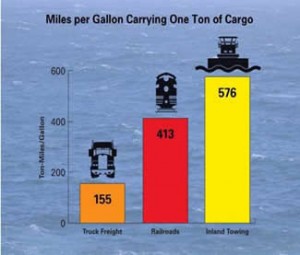Can cheap water transport ease our roads?
Think $10 diesel.
Think container barges and ferries and docks.
Our city lost a big business opportunity. We won’t be hosting the America’s Cup yacht races in 2013, partly because we have no more waterfront. Newport’s wharves, once a beehive of boatyards, sailmakers, and chandlers, are mostly condos now.
Bringing today’s hugely expensive yachts, crew, and support facilities back to downtown Newport would have brought millions of competitor and spectator dollars. Instead that bonanza will go to San Francisco.
 Yes, we have some attractive housing instead, even the sort of walkable mixed-use neighborhood that I’ve been touting on these pages. But we’ve lost the opportunity to use waterfront for water-related businesses. And given where the price of energy may be heading, this could be an economic mistake for Newport, and for many other cities.
Yes, we have some attractive housing instead, even the sort of walkable mixed-use neighborhood that I’ve been touting on these pages. But we’ve lost the opportunity to use waterfront for water-related businesses. And given where the price of energy may be heading, this could be an economic mistake for Newport, and for many other cities.
And waterfront tourism and entertainment, like yacht races, may be the least of it.
Some planners believe waterfront industry and commerce will have a resurgence. The Director of City Planning in Vancouver, BC, a particularly forward-thinking city, tells why.
“A theory abounds – and it is only a theory at this point – that the future will see an increasing need for downtown industrial lands, particularly on waterfronts, as manufacturers and light industrial players seek shorter routes to market for their products. . . I think we’re going to see a change in globalization because of energy costs. Cities that have preserved their flexible job-space land are going to be the more resilient, successful cities in the future.”
As fuel prices rise and America’s roads and bridges decay, manufacturers and distributors will thrive by having low-cost access to their customers. Barges can move a ton of cargo almost 600 miles on a single gallon of fuel, trucks only a quarter as far. Ferries too can be cost-effective transportation. And unlike rails or highways, we don’t have to build and repair the sea surface.
There are attractions to gentrifying a city’s waterfront, including aesthetics, a bigger tax base, and open space. But looking at the ways high-price fuel would transform the economic and physical landscape, communities that save waterfront for future water-related transportation, shipping, and even manufacturing businesses could see big economic advantages.



